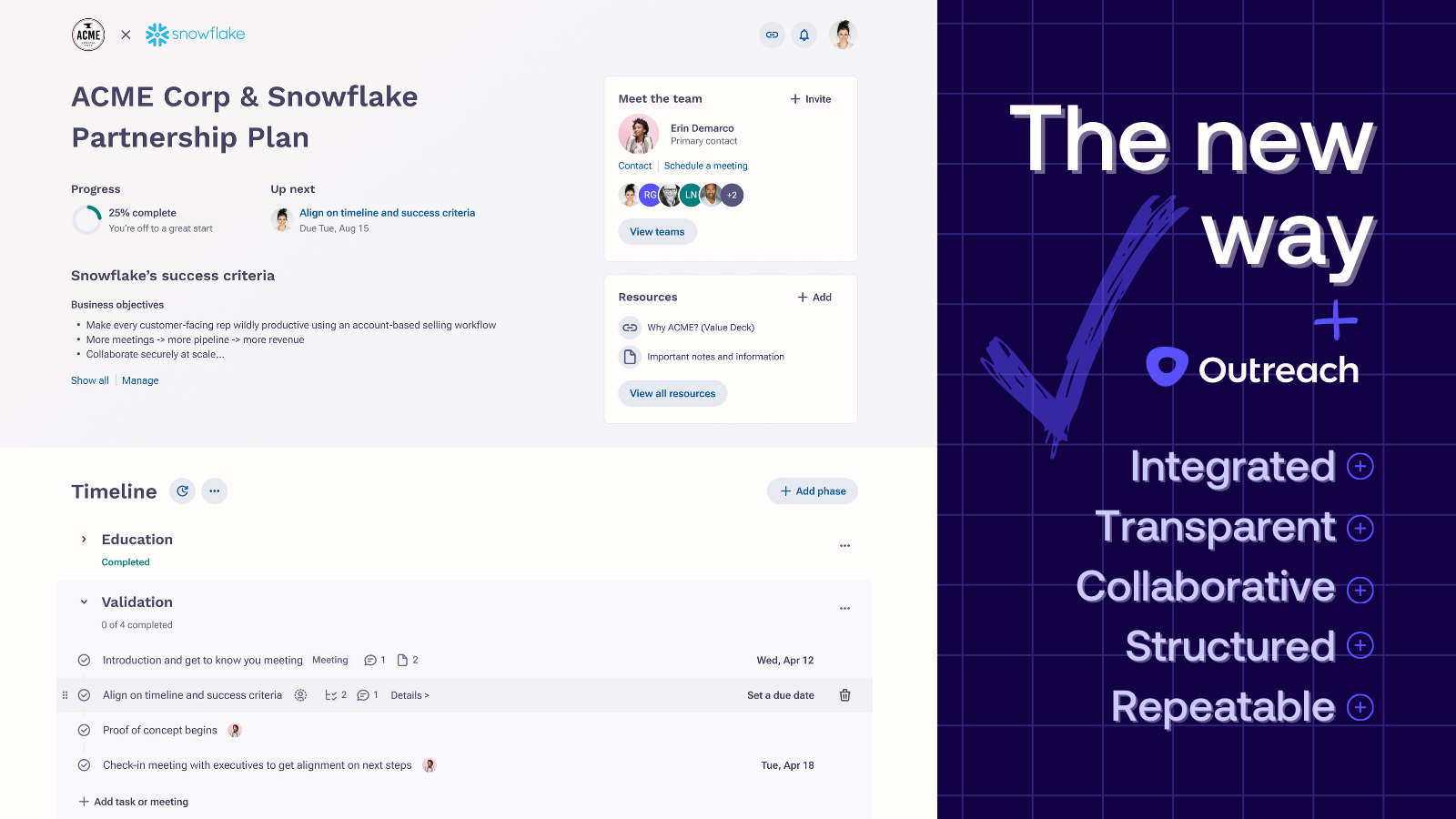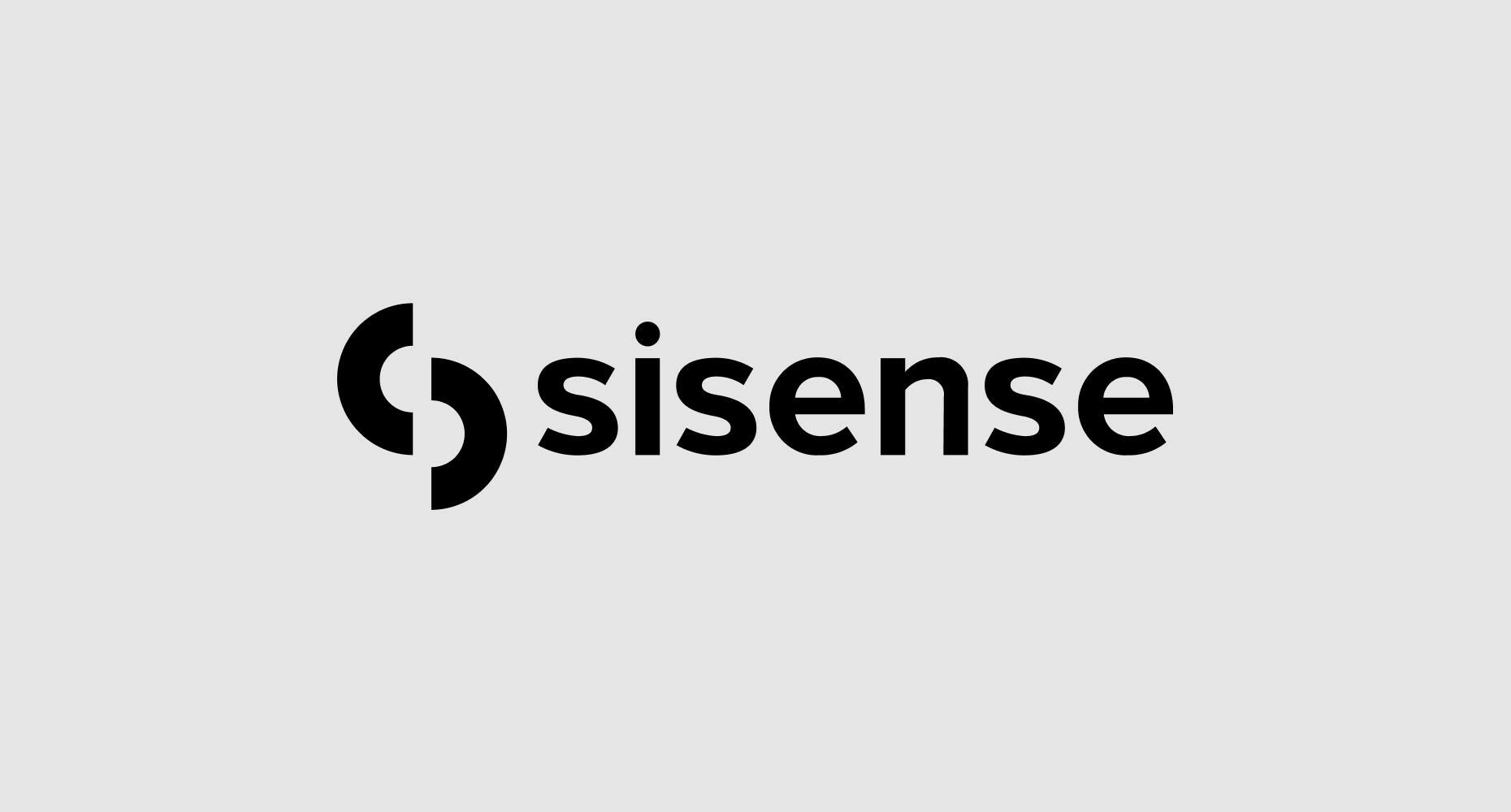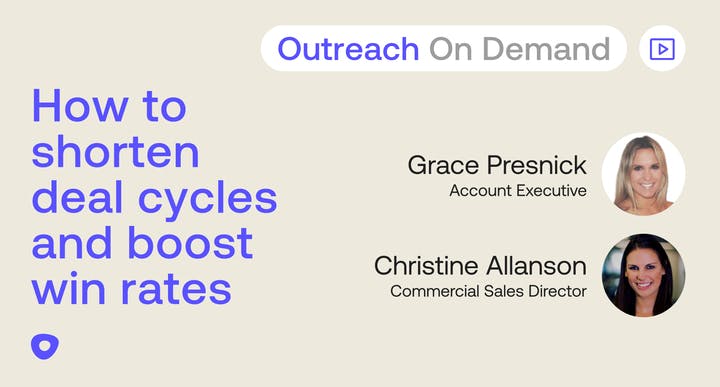Deals today are more competitive than ever. Average deal cycles are longer and involve more stakeholders. It’s not unusual to see deals stall or fall apart in the eleventh hour when a champion leaves or finance pulls the plug. Keeping buyers engaged and aligned is tough, but it’s not impossible. There are ways to make it easier and repeatable — both at the deal level and across your entire sales team using mutual action plans (or MAPs for short).
Across Outreach, we see that deals where AEs have engaged buyers with a mutual action plan have a 26% higher win rate than those without. For my fellow AEs who already use MAPs, this should come as no surprise. After all, a MAP keeps buyers and sellers aligned on the timeline, steps, stakeholders, and success criteria required to close a deal. When buyers are more engaged, the deal is more likely to succeed.
Despite the evidence, I still see sales organizations that haven’t figured out how to use their tool to their advantage. An informal LinkedIn poll confirms my hunch that the majority of sales professionals are not consistently using MAPs today.
With some careful planning, any sales team can (and should!) bake MAPs into their process. Here, we’ll dive into the obstacles teams face when implementing plans, plus five best practices to avoid them.
See why AEs that use MAPs have a 26% higher win rate than those who don’t
Watch this demo of Outreach Success Plans to learn:
- How sales leaders use Outreach to operationalize qualification methodologies like MEDDPICC, MEDDIC, BANT, or SPIN
- How top-performing AEs use mutual action plans to align with all stakeholders
- How to avoid potential deal-killing scenarios, such as a departing champion or new stakeholders entering the deal
What is a mutual action plan?
A mutual action plan (MAP) is just a framework used in sales to collaborate and align on the goals and expectations of both the seller and the buyer. Designed to guide the sales process, MAPs ensure transparency and create a clear roadmap to closing a deal.
Traditional MAPs have an adoption issue: Here’s how to fix that
Mutual Action Plans aren’t new — but they’re also not always a consistent part of sales teams selling processes. Traditionally, sellers build their plans manually, resulting in a host of issues for AEs and their managers:
- Inconsistent: When sellers create their own templates or don’t capture the same qualification criteria it leads to gaps in information.
- Disconnected: When saved in a separate document or deck, a MAP just becomes another place sellers need to remember to update.
- Poor visibility: If buyers aren’t aware of or engaged with the plan, deals stall out. Similarly, sales managers struggle to monitor progress, offer support, or reliably forecast.
The good news: there are ways to incorporate mutual action plans into your existing sales processes. Within Outreach, for example, reps can add templatized Success Plans for every opportunity. This helps buyers and sellers align on their goals, requirements, and buying process. At the same time, sales managers have clear visibility into what’s going on and the level of engagement of deals in the pipeline.
What to include in your plan: 5 best practices
While we’re using Outreach as an example, these tips apply to anyone building a mutual action plan, whether you use Outreach or not. Outreach users have the benefit of adding a mutual action plan to any opportunity in the platform.
1. Break the sales process into steps with timelines
Your plan should mirror your sales process in customer-facing terms. For example, discovery and qualification stages might be labeled as Education and Validation steps on your plan. By setting out specific actions, milestones, and timelines, we can stay on track and understand the steps and time required to reach a successful outcome.
2. Assign responsibilities, deliverables, and milestones
We want the plan to be top of mind with our buyers. So, I add “Success Plan Review” as one of my first project milestones. Early in the deal, I’ll take 30 minutes with a champion to talk through the success metrics, initiatives, and our typical sales process. From there, I can work with my buyer to identify and add other milestones from their side too.
3. Share the MAP with all stakeholders
Once the key stakeholders are identified, share the plan with them. I’ll also continue to reference the plan at the beginning and end of every meeting. That way, as new stakeholders enter the picture, we can show them everything we’ve accomplished so far and adjust or capture new success criteria.
4. Templatize to standardize
Create templates with pre-populated steps, like renewals vs new business, for example. This is another way to ensure that every seller is following a similar sales process, qualification criteria, or sales methodology. At Outreach, we use MEDDPICC, but you can easily bake in any sales methodology directly into your mutual action plan template.
5. Include customer value and outcomes to drive alignment
At Outreach, we include success criteria as part of every mutual action plan. This is a great way to keep momentum going as tougher stakeholders enter the deal. If a CRO or CFO joins a meeting, I can get everyone aligned on the value we’re bringing, whether that’s core business objectives or specific product capabilities.
Consistency is key to keeping your buyers engaged
Remember, a well-crafted MAP is not just a tool for the sales team; it's a roadmap to success for both the seller and the buyer. Implementing these best practices in your mutual action plans can bring more visibility and consistency to your sales process. The result: clearer qualification criteria, more engaged buyers, and ultimately, more closed deals.
Improve your win rates with Outreach
Outreach makes aligning with customers through mutual action plans easy with Success Plan templates — chat with our sales team to learn what it could do for you
Stay up-to-date with all things Outreach
Get the latest product news, industry insights, and valuable resources in your inbox.







